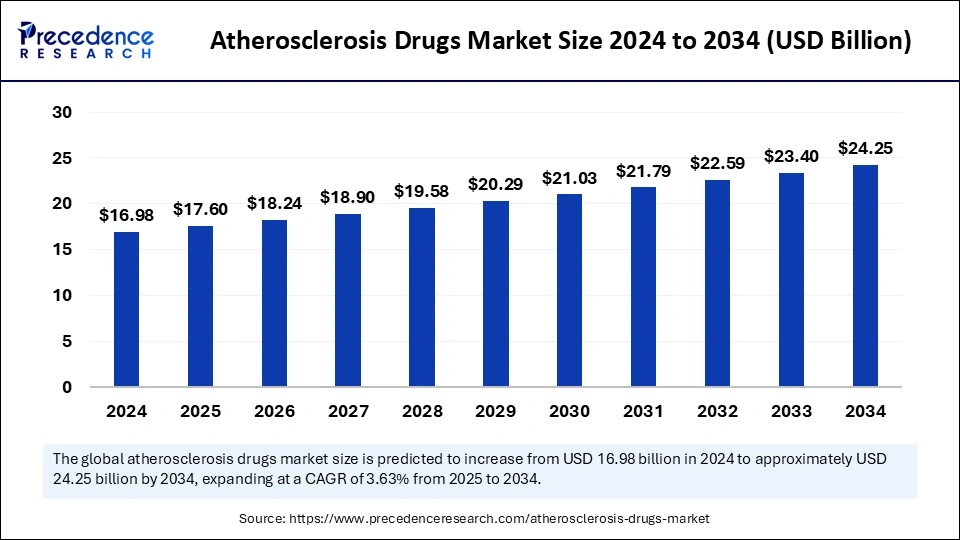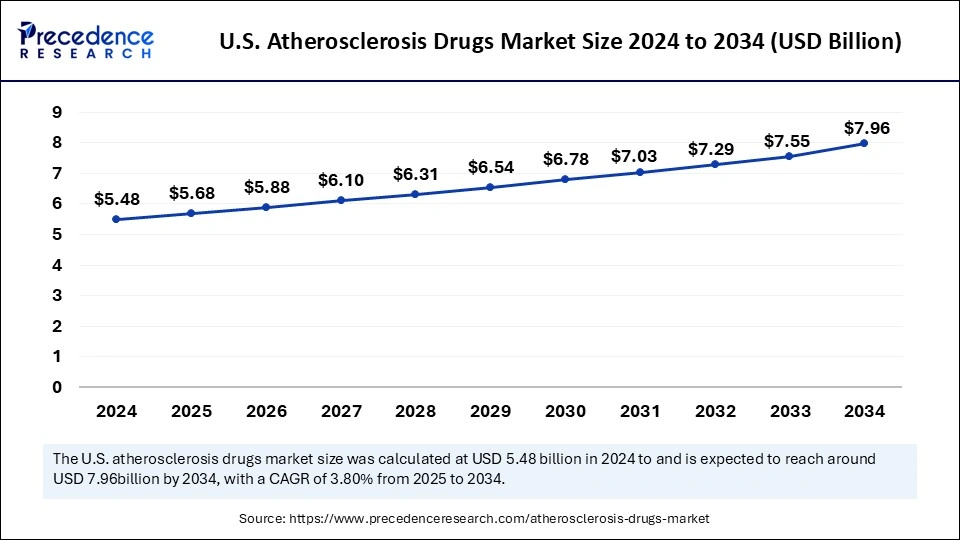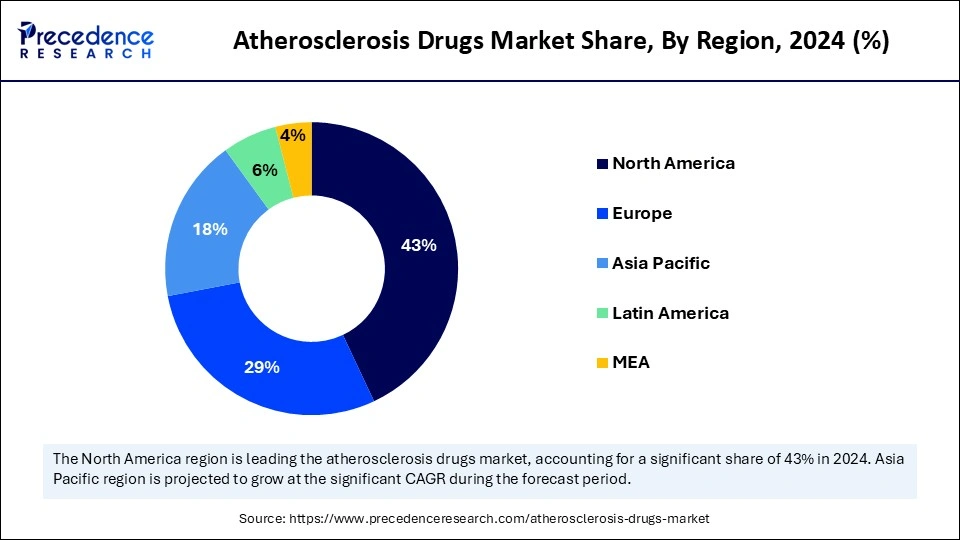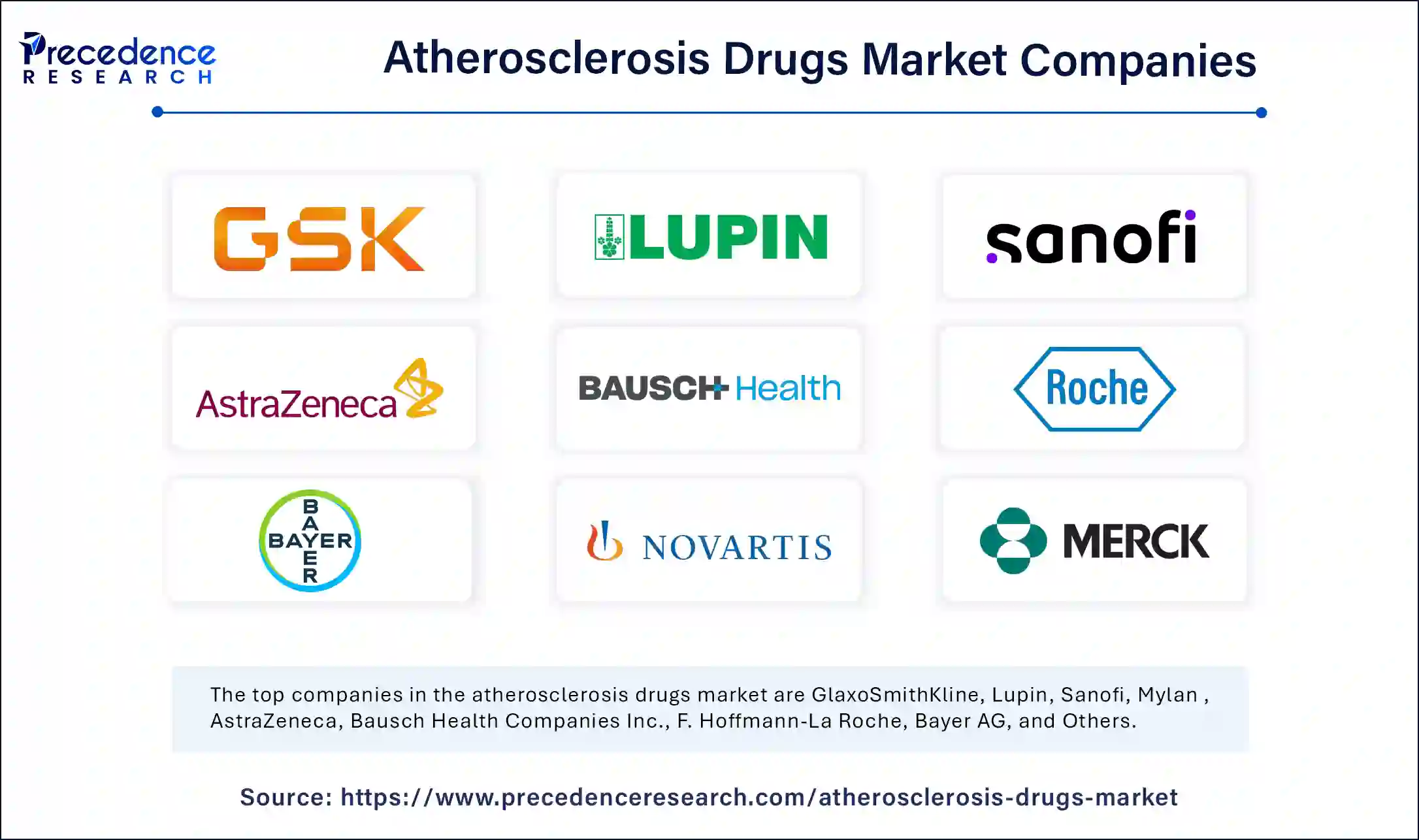January 2025
The global atherosclerosis drugs market size is calculated at USD 17.60 billion in 2025 and is forecasted to reach around USD 24.25 billion by 2034, accelerating at a CAGR of 3.63% from 2025 to 2034. The North America market size surpassed USD 7.30 billion in 2024 and is expanding at a CAGR of 3.75% during the forecast period. The market sizing and forecasts are revenue-based (USD Million/Billion), with 2024 as the base year.
The global atherosclerosis drugs market size was estimated at USD 16.98 billion in 2024 and is predicted to increase from USD 17.60 billion in 2025 to approximately USD 24.25 billion by 2034, expanding at a CAGR of 3.63% from 2025 to 2034. The growing prevalence of obesity and diabetes are key drivers of the market. Additionally, the growing prevalence of cardiovascular disease is contributing to the market growth. An aging population is expected to fuel global market growth in the forecast period.

Artificial intelligence is the key transformer of the global atherosclerosis drugs market. AI allows help for the development of personalized medicine plans and schedules for patients with atherosclerosis. AI is enabled to analyze and detect disease progressions, which helps for early treatments and interventions. Researchers are finding AI a lifesaver due to its ability to detect suitable patients for the study, optimize trials, and analyze overall results.
With the help of AI, manufacturers and scientists can find easy ways to develop novel drugs, as AI can analyze large databases, improve the efficacy of drug discovery, and detect targets. Virtual assistants are able to enhance patient engagement and education. The growing adoption of wearable devices, virtual clinical trials, and developments of precision medicines are influencing the atherosclerosis drugs market.
The U.S. atherosclerosis drugs market size was evaluated at USD 5.48 billion in 2024 and is projected to be worth around USD 7.96 billion by 2034, growing at a CAGR of 3.80% from 2025 to 2034.

North America dominated the global atherosclerosis drugs market with the largest share in 2024 due to the presence of well-established pharmaceutical, biopharmaceutical, and healthcare sectors in the region. North America has an advanced healthcare system and high-quality medical care and treatments. The United States accelerated its biggest market share due to the large aging population in North America and anticipated major risks of obesity and diabetes in the country. Moreover, strong research & development sectors, along with major research institutes and universities.
The high adoption rate of novel and cutting-edge technologies is boosting the healthcare & pharmaceutical sector of the country. Moreover, the high standard of living lifestyle is seeking premium treatment options in the United States. The presence of favorable reimbursement policies, like government funding for research as well as healthcare insurance coverage, is making it easier to adopt personalized treatment options in the region. With government support for research and development of novel drugs, North America is expected to develop cutting-edge solutions for this deadly disease.

Asia Pacific is anticipated to grow at the fastest CAGR in the atherosclerosis drugs market during the forecast period due to regional reach by pharmaceutical companies. Government and non-government bodies support the regional pharmaceutical companies seeking doors for the development of cutting-edge treatments for atherosclerosis. The growing aging population and demand for premium treatments and medications are encouraging manufacturers in the region to develop novel therapies.
Asia has the largest market for generic drugs, along with many pharmaceutical companies offering affordable and high-quality generic versions for atherosclerosis disease. Additionally, government initiatives for the promotion of awareness of chronic disease and investments in regional healthcare infrastructure are anticipated to develop market success with regulatory framework support for the development and innovations of new drugs and pharmaceutical companies.
Atherosclerosis is a condition in which plaque clogs arteries and causes cardiac issues like stroke and heart attack. It can develop in early stages, like childhood. The prevalence of cardiovascular disease & atherosclerosis disease has increased, which is driving the growth of the atherosclerosis drugs market. The changed lifestyle in urban areas is driving the prevalence of high blood pressure, high cholesterol, and obesity, as high consumption of alcohol leads to enhanced such diseases.
The consumption of packaged foods, carbohydrate-based foods, and poor eating habits are leading to increased risks of atherosclerosis. An aging population and the growing importance of health & wellness are the crucial factors driving the growth of the atherosclerosis drugs market. The real causes of atherosclerosis haven’t been discovered yet; however, the market has witnessed significant trends due to the adoption of cholesterol-lowering medications for treating high cholesterol and cardiovascular disease.
With the constant determination of scientists to research and develop causes and treatments for atherosclerosis, market growth is projected to take a high flight in the upcoming period. Governments and regulatory frameworks are initiating R&D of novel yet cost-effective drugs to provide better health care for people. Government initiatives like investing in and supporting healthcare infrastructure, research teams, and promoting awareness about atherosclerosis treatment options.
| Report Coverage | Details |
| Market Size by 2034 | USD 24.25 Billion |
| Market Size in 2025 | USD 17.60 Billion |
| Market Size in 2024 | USD 16.98 Billion |
| Market Growth Rate from 2025 to 2034 | CAGR of 3.63% |
| Dominating Region | North America |
| Fastest Growing Region | Asia Pacific |
| Base Year | 2024 |
| Forecast Period | 2025 to 2034 |
| Segments Covered | Drug Type, Route of Administration, Distribution Channel, and Regions. |
| Regions Covered | North America, Europe, Asia-Pacific, Latin America, and Middle East & Africa |
Increased adoption of combination therapies
The adoption of combination therapies increased due to their effectiveness in minimizing the risk of cardiovascular events like heart attacks and strokes. Combination therapies offer better safety compared to monotherapies as they can reduce the risk of adverse reactions. Increased patient compliance is able to make it easy for patients to follow their medication schedules; also, combination therapies help patients avoid pill burden. The growing demand for personalized medicine and targeted therapies is driving approaches toward combination therapies in the atherosclerosis drugs market. Moreover, regulatory frameworks support the research and development of novel combination therapies that enhance the availability of combination treatment options. The adoption of combination therapies can reduce healthcare costs, prevent people from cardiovascular risk, and enhance patient outcomes.
High cost of innovative therapies
The novel therapy options with cutting-edge and personalized medicines are highly expensive. These therapies can be costly for manufacture as well as administration. The expensiveness of such therapies causes limitations in the adoption rate. Developing areas are left out of the benefits of advanced therapies due to low accessibility and cost. Additionally, the high cost of innovative therapies can also impact healthcare disparities.
Complexity in regulations like testing and approval processes can lead to a cost burden on the production and distribution sectors of the atherosclerosis drugs market. Moreover, regulatory hurdles like pricing negotiations and reimbursement challenges can be caused due to the high cost of innovative therapies. The affordability of biosimilars and generic drugs can hamper the growth of innovative therapies.
Novel drug delivery systems
Novel drug delivery systems like nanoparticle-based drug delivery systems, liposome-based, polysaccharide-based, and microneedle-based drug delivery systems are opening doors for the growth of the atherosclerosis drugs market in the forecast period. Nanoparticle-based drug delivery systems help to target specific cells or tissues, reduce side effects, and improve the bioavailability of the drugs. Similarly, liposome-based and polysaccharide-based drug delivery systems improve cellular uptake, biocompatibility & biodegradability and enhance targeted delivery, improving the efficacy of drugs.
The development of painless and minimally invasive microneedle-based drug delivery systems is witnessing significant adoption rates. With the growing prevalence of cardiovascular disease and obesity, the need for highly efficient and safe drugs is targeting the market. The development of novel and advantageous treatment options is expected to boost the market in the upcoming period. The ability of such novel drugs to reduce healthcare costs and make healthcare more affordable and personalized.
The anti-platelet and anticoagulants segment contributed the highest atherosclerosis drugs market share. Antiplatelet and anticoagulant drugs are highly effective in the prevention of heart attacks and strokes in patients with atherosclerosis. Additionally, it has been detected that anti-platelet and anticoagulant drugs are helpful in reducing morbidity and mortality in patients with atherosclerosis. Growing awareness of cardiovascular disease is leading to increased demands for effective treatments. The growing prevalence of atherosclerosis is driving demands for effective treatment options, driving the growth of the segment. Additionally, expanding healthcare expenditure and ongoing research for the development of innovative treatments are expected to boost segment expansion.
The oral segment contributed the highest atherosclerosis drugs market share in 2024 due to its convenience and easy administration. Oral administration is known for its ease of use and minimal discomfort. Additionally, oral drugs have better bioavailability, which is easily absorbed into the bloodstream. Such drugs have clinical efficacy in reducing the risk of cardiovascular risks. Due to safety, efficacy, and minimal side effects, patients mostly prefer drugs for oral administration. Moreover, oral atherosclerosis drugs are affordable compared to other administration options, making them more demandable.
The drug stores and retail pharmacies segment led the global atherosclerosis drugs market. The growth of the segment is anticipated due to the easy availability and accessibility of drug stores and retail pharmacies in urban as well as rural areas. Convenient locations of such stores make it easy for patients to purchase their medications. Increased awareness about cardiovascular risks and health management among people is highly contributing to the segment's expansion. An efficient supply chain helps to maintain a steady inventory of medications. The ability to offer personalized services with effective counseling and advice on medication doses and routes is making them more popular.

By Drug Type
By Route of Administration
By Distribution Channel
By Geography
For inquiries regarding discounts, bulk purchases, or customization requests, please contact us at sales@precedenceresearch.com
No cookie-cutter, only authentic analysis – take the 1st step to become a Precedence Research client
January 2025
March 2025
March 2025
March 2025